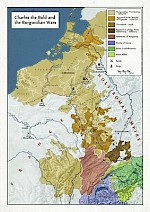MW IV.4
In the next week or so, Medieval Warfare IV-4 will be shipped to subscribers and buyers. The issue focuses on The Burgundian Wars, the conflict between Burgundian Duke Charles the Bold and the Old Swiss Confederacy (and their allies). The final battle saw the death of Charles, and would be the end of the rising power of the Burgundian Dukes, thus mostly benefitting the major powers of France and the Holy Roman Empire. The issue’s articles cover several important features and events related to the conflict.
 The introduction by Jean-Claude Brunner (an important contributor to this issue) offers an overview of the conflict, discussing the causes and the course of the war. Important in this regard was the belligerence of several leaders in the area, including some members of the Swiss Confederacy, who, like Charles, had no moral qualms about attacking neighbouring counties if it could increase their power. Aside from the political implications, these Swiss attacks were all the more dangerous because of the effectiveness of their infantry, a topic which is covered in Robert Holmes article on the Swiss forces during the war. Their organization and tactics allowed them to field a large army in a short period, one which could march quickly and thus seize the initiative on the battlefield. They were popular mercenary forces during the Late Middle Ages, but their shortcomings made sure that other types of warfare were also tried and tested, finally leading to the combined arms forces of the 16th century. Of equal importance for the creation of such a force was the new tactical organization of Charles the Bold’s reformed army, with a focus on mobile cavalry and ranged units, including his clever use of artillery in battle. Gabriele Esposito focuses on the Burgundian Lance and Charles’ reforms in the next article of the issue.
The introduction by Jean-Claude Brunner (an important contributor to this issue) offers an overview of the conflict, discussing the causes and the course of the war. Important in this regard was the belligerence of several leaders in the area, including some members of the Swiss Confederacy, who, like Charles, had no moral qualms about attacking neighbouring counties if it could increase their power. Aside from the political implications, these Swiss attacks were all the more dangerous because of the effectiveness of their infantry, a topic which is covered in Robert Holmes article on the Swiss forces during the war. Their organization and tactics allowed them to field a large army in a short period, one which could march quickly and thus seize the initiative on the battlefield. They were popular mercenary forces during the Late Middle Ages, but their shortcomings made sure that other types of warfare were also tried and tested, finally leading to the combined arms forces of the 16th century. Of equal importance for the creation of such a force was the new tactical organization of Charles the Bold’s reformed army, with a focus on mobile cavalry and ranged units, including his clever use of artillery in battle. Gabriele Esposito focuses on the Burgundian Lance and Charles’ reforms in the next article of the issue.
 Around the start of the conflict, it was still very likely that England, France and the Holy Roman Empire would be drawn in as well. In a game of political manoeuvring, Charles, French King Louis, Edward IV of England and Emperor Frederick II tried to gain the upper hand; the stage was set for a large scale conflict which would include the larger powers as well. However, Charles’ siege of Neuss influenced matters to such a degree that the Duchy of Burgundy would end up fighting only against the Swiss and allies. How this came to be is explained by Gareth Williams in his account of the siege. Some time later, Charles took his army against the Swiss, but his newly reformed army was defeated at the Battle of Grandson, covered in detail by Matthew Beazley. Despite his defeat, he managed to gather a new army, one which did not fare any better at the subsequent Battle of Morat (which has already been covered in MW I-4). Despite this second disaster, Charles pressed on to campaign against Duke René of Savoy. This decision would prove to be fatal, as he was killed at the Battle of Nancy. The details of this battle are discussed by Sidney Dean.
Around the start of the conflict, it was still very likely that England, France and the Holy Roman Empire would be drawn in as well. In a game of political manoeuvring, Charles, French King Louis, Edward IV of England and Emperor Frederick II tried to gain the upper hand; the stage was set for a large scale conflict which would include the larger powers as well. However, Charles’ siege of Neuss influenced matters to such a degree that the Duchy of Burgundy would end up fighting only against the Swiss and allies. How this came to be is explained by Gareth Williams in his account of the siege. Some time later, Charles took his army against the Swiss, but his newly reformed army was defeated at the Battle of Grandson, covered in detail by Matthew Beazley. Despite his defeat, he managed to gather a new army, one which did not fare any better at the subsequent Battle of Morat (which has already been covered in MW I-4). Despite this second disaster, Charles pressed on to campaign against Duke René of Savoy. This decision would prove to be fatal, as he was killed at the Battle of Nancy. The details of this battle are discussed by Sidney Dean.
 For the non-theme articles in this issue, we have selected several diverse topics. First and foremost, this issue contains the first article in a series on medieval weaponry, from now on a standard feature in upcoming issues of Medieval Warfare. This first article, by Gareth Williams, focuses on the mace, a simple but very effective counter to the development of ever more elaborate armour in the Middle Ages. Next, Gregory Liebau highlights some passages from 12th century German epics Tristan and Iwein to explain the impact such epics had on the evolution and spread of chivalry in the medieval world. Last but not least, Ray Cavanaugh offers an entertaining account of the life of Viking warrior poet Egil Skallagrímsson, a product of Viking violent society, whose turbulent life fittingly seemed to have ended with the spread of Christianity in Iceland.
For the non-theme articles in this issue, we have selected several diverse topics. First and foremost, this issue contains the first article in a series on medieval weaponry, from now on a standard feature in upcoming issues of Medieval Warfare. This first article, by Gareth Williams, focuses on the mace, a simple but very effective counter to the development of ever more elaborate armour in the Middle Ages. Next, Gregory Liebau highlights some passages from 12th century German epics Tristan and Iwein to explain the impact such epics had on the evolution and spread of chivalry in the medieval world. Last but not least, Ray Cavanaugh offers an entertaining account of the life of Viking warrior poet Egil Skallagrímsson, a product of Viking violent society, whose turbulent life fittingly seemed to have ended with the spread of Christianity in Iceland.
A few images and artwork from the issue are shown here in low resolution. Of course, if you want to see them in all their glory, you’ll have to check out the issue itself.
If you order now, you will benefit from a 15 % discount. That said, buying a subscription is still the cheapest way to acquire this and future issues of Medieval Warfare. If you are interested in the latter option, make sure to place your order before the latest issue has arrived at our distribution center, so that MW IV-4 will be included in the subscription.
